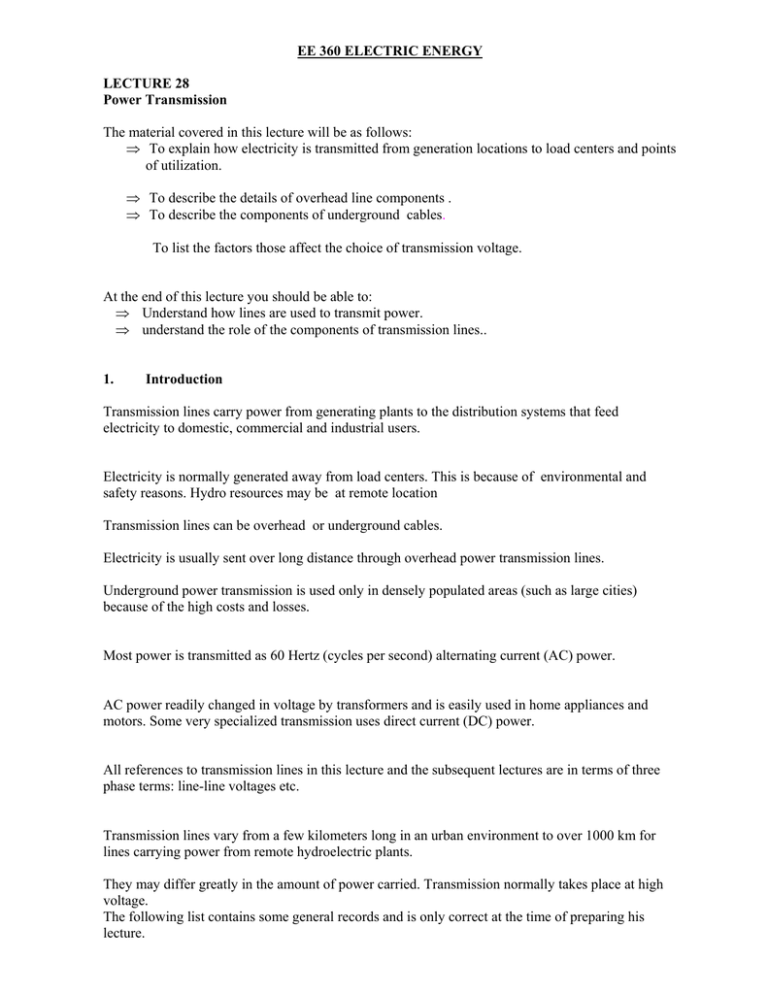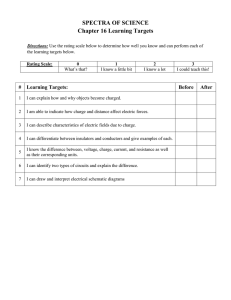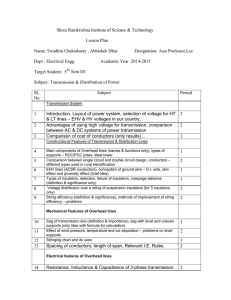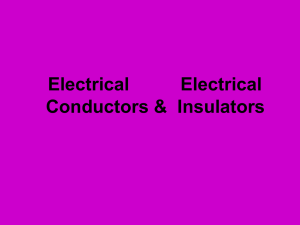EE 360 ELECTRIC ENERGY LECTURE 28 Power Transmission
advertisement

EE 360 ELECTRIC ENERGY LECTURE 28 Power Transmission The material covered in this lecture will be as follows: ⇒ To explain how electricity is transmitted from generation locations to load centers and points of utilization. ⇒ To describe the details of overhead line components . ⇒ To describe the components of underground cables. To list the factors those affect the choice of transmission voltage. At the end of this lecture you should be able to: ⇒ Understand how lines are used to transmit power. ⇒ understand the role of the components of transmission lines.. 1. Introduction Transmission lines carry power from generating plants to the distribution systems that feed electricity to domestic, commercial and industrial users. Electricity is normally generated away from load centers. This is because of environmental and safety reasons. Hydro resources may be at remote location Transmission lines can be overhead or underground cables. Electricity is usually sent over long distance through overhead power transmission lines. Underground power transmission is used only in densely populated areas (such as large cities) because of the high costs and losses. Most power is transmitted as 60 Hertz (cycles per second) alternating current (AC) power. AC power readily changed in voltage by transformers and is easily used in home appliances and motors. Some very specialized transmission uses direct current (DC) power. All references to transmission lines in this lecture and the subsequent lectures are in terms of three phase terms: line-line voltages etc. Transmission lines vary from a few kilometers long in an urban environment to over 1000 km for lines carrying power from remote hydroelectric plants. They may differ greatly in the amount of power carried. Transmission normally takes place at high voltage. The following list contains some general records and is only correct at the time of preparing his lecture. Highest transmission voltage (AC): 1150 kV (Kazakhstan) Highest transmission voltage (DC): +/-600 kV (Brazil) Longest transmission line: Democratic Republic of Congo (length: 1700km) Longest submarine cables Baltic-Cable, Baltic Sea - (length of submarine/underground cable: 249 km, total length: 261 km) .. The definition of the transmission voltage varies from a system to a system. In Saudi Arabia the highest transmission voltage is 380 kV. Other transmission voltages are also used :230 kV, 132 kV, 115-110 kV This is correct in 2006. Higher voltage may be realized in the near future. 2. Transmission Line Construction An overhead transmission line is made of conductor, insulators and a tower. An underground cable is made of conductor, insulation and is buried into ground. The three phase conductors carry the electric current. Insulators provide support and electrically isolate the conductors. Tower holds the insulators and conductors. It is firmly grounded with special foundation and Optional shield and ground conductors protect against lightning Figure 1 shows a typical transmission line tower together with conductors and insulators. Figure 1 Transmission Line Figure 2 shows a typical transmission line tower. Shield conductors Bundled conductor )four conductors( Insulator Tower Grounding rod Foundation Figure 2 Transmission Tower 2. Overhead Line Components 2.1 Conductors Transmission line conductors are normally made from Aluminum with certain reinforcements. Copper is not usually at high voltage because of its costs even though it has a very low resistance. The conductors are made of aluminum strands which are reinforced by another material. Stranded conductors are simpler to manufacture, easier to handle and more flexible. The reinforcement, by steel for instance, provides a high strength-to-weight ratio. Aluminum conductors are classified as follows: • • • Aluminum Conductor Steel Reinforced (ACSR) All Aluminum Conductor (AAC); and All Aluminum Alloy Conductor (AAAC) Figure 3 shows a cross-section of an ACSR conductor. Aluminum outer strands 2 layers, 30 conductors Steel core strands, 7 conductors Figure 3 An ACSR conductor The conductor is made of 30 Aluminum strands and 7 steel strands. The electric current is carried by the aluminum strands while the steel strands provide mechanical support. Overhead line conductors are usually bare without any insulation. Bare conductors have excellent heat dissipation characteristics. Also insulating high voltage conductors will be economically prohibitive. High voltage lines often may have more than one conductor per phase. This arrangement is referred to as Bundle- conductor arrangement. Figure 4 shows arrangements for system of 2, 3 and 4 bundle conductors. Figure 4 Bundle Conductor arrangements Bundle conductors have lower electric strength at the surface. This controls the occurrence of corona. Corona is defined as the ionization of gas around transmission lines. It is manifested by a hissing sound and in some extreme conditions a glowing light around the conductors. The subject of corona and its effects will be addressed in advanced EE courses. 2.2 Insulators Insulators are used to support, anchor and insulate conductors from ground. They are made of porcelain, glass and several synthetic materials. Electrically, insulators must provide high resistance to leakage currents and they have to withstand certain voltage without damage. Mechanically, they must withstand the pull due to the conductor weight. There are two types of insulators: pin and suspension types. Suspension type are usually used for high voltage line. A number of insulators usually form a string between the conductors and the tower cross arms. Figure 5 shows a typical insulator Locking Key Insulator's Head Iron Cap Ball Socket Compression Loading Expansion Layer Cement Imbedded Sand Insulating Glass or Porcelain Skirt Petticoats Steel Pin Corrosion Sleeve for DC Insulators Ball Figure 5 A Typical Transmission Insulator. The number of insulators is dictated by the voltage level of the line. Once again, the subject of insulators will be addressed in advanced EE courses. 2.3 Towers or Supporting structures A structure is needed to keep conductors at a safe height from the ground. It should also provides a acceptable distance between phase conductors to avoid arcing. Wood and concrete poles are used for low voltage lines. High voltage lines use steel towers. Figure 2 earlier showed a transmission steel tower. The design and height of the tower depends on many factors: transmission voltage, ground terrain, atmospheric conditions and environmental constraints 3. Cable Components The term cable refers to both underground and submarine cables. Underground cables are buried below the ground while submarine cables are used for water crossings . Figure 6 shows a single core high voltage cable. Figure 6 A Single Phase Cable The cable components are: 1. Stranded phase Conductor. 2. A conductor sheath 3. Insulating material: solid or oil-filled. 4. Insulation shield . 5. Copper screen or armor 6. External jacket ( mostly PVC). Cable insulation material vary widely. The following are widely used 1. 2. 3. 4. Oil impregnated paper Gas such as SF6 Polyvinyl Chloride (PVC) Cross linked Poly Ethylene (XLPE) The choice of the insulation depends on the cable voltage. 4. Transmission Line Design Transmission line design is covered in details in advanced EE courses However, in this section, we will highlight the factors that influence the design. These are electrical, mechanical, environmental and economical factors. a. electrical factors These dictate 1. Type, size, and number of conductors per phase 2. The number of insulators per string and their arrangements. 3. Phase-to-phase clearance 4. Number of shield or ground conductors. b. mechanical factors Conductors must be strong enough to support their weight in addition to wind . Towers must support conductors under vibration. c. Environmental a. land usage and visual impact. b. limits of electrostatic and electromagnetic fields c. Radio interference and corona noise. d. Economical 1. Capital costs 2. Maintenance and operation costs





